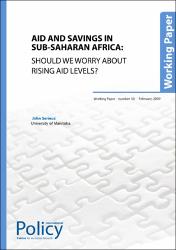Please use this identifier to cite or link to this item:
https://repositorio.ipea.gov.br/handle/11058/15127Files in This Item:
| File | Description | Size | Format | |
|---|---|---|---|---|
| en_IPCWorkingPaper50.pdf | 386.28 kB | Adobe PDF |  View/Open |
| Title: | Aid and Savings in Sub-saharan Africa: Should we Worry about Rising Aid Levels? |
| Authors: | Serieux, John |
| Abstract: | This paper examines the effect of aid on domestic savings in Sub-Saharan Africa. It departs from the previous literature on aid and savings in developing countries by abandoning the pervasive, but untenable, assumption that all aid is used to expand the trade deficit and thus applied wholly to consumption or investment. In fact, for the period 1965-2006, the evidence suggests that 35% of any increase in aid relative to output was used to finance reverse flows (some combination of interest payments, debt amortization, capital flight and reserve increases), 41% was used to increase consumption relative to output (meaning a reduction in the domestic savings rates) and 24% was used to increase the rate of investment. However, during the extended period of increasing aid levels from the early 1970s to mid 1990s, reverse flows were a larger proportion of aid but more aid was invested and less was consumed. Also, concerns about potential aid hangovers, when current high aid levels subside, can be assuaged by the evidence that that effect has been historically uncommon in the region despite many episodes of high aid levels followed by sharp declines. (...) |
| metadata.dc.rights.holder: | International Policy Centre for Inclusive Growth United Nations Development Programme |
| metadata.dc.rights.license: | O texto e dados desta publicação podem ser reproduzidos desde que as fontes sejam citadas. Reproduções com fins comerciais são proibidas. |
| metadata.dc.type: | Working Paper |
| Appears in Collections: | Publicações do IPC-IG |
Items in DSpace are protected by copyright, with all rights reserved, unless otherwise indicated.

